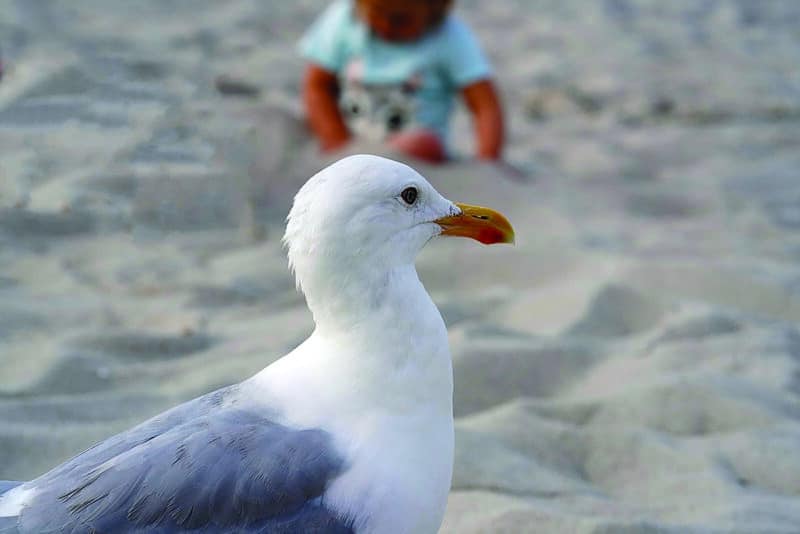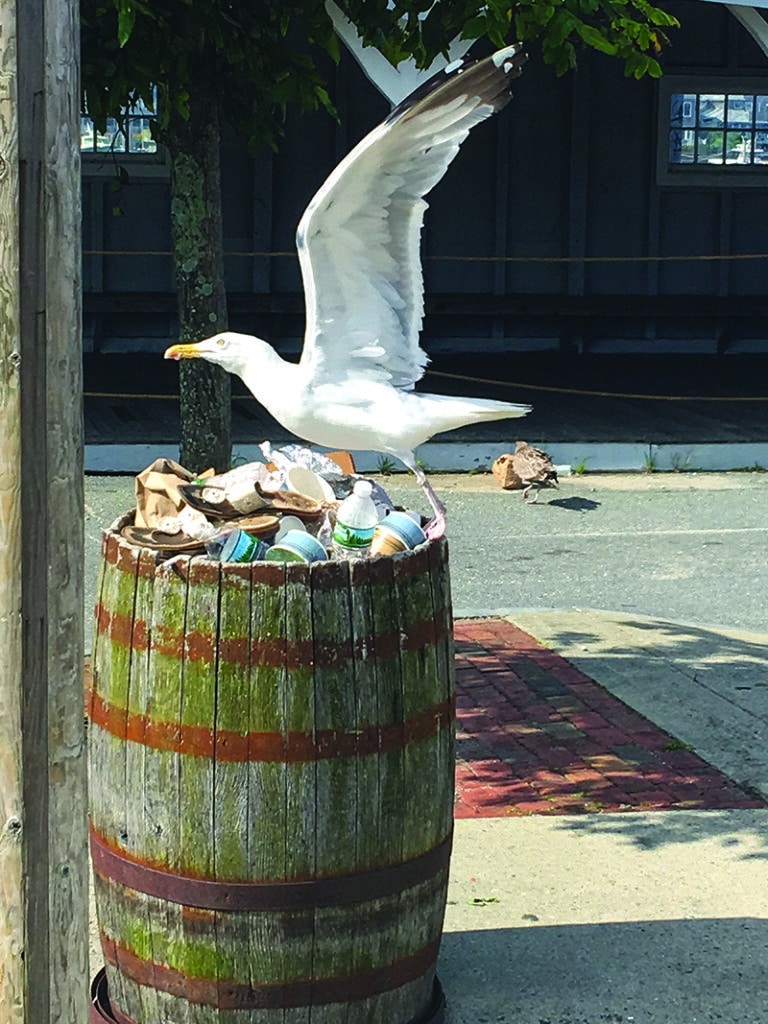by Dr. Sarah Treanor Bois, PhD
Director of Research & Education at the Linda Loring Nature Foundation
You may have heard about the recent theft that occurred at Stop and Shop. A man’s wallet was stolen from his cart right in the parking lot. It was front page news! Ok, it wasn’t front page news, but the perpetrator was identified as a frequent culprit of such crimes—a seagull.
If I were to defend the alleged perpetrator in court, I would definitely win the argument. How can I be so sure? What defense could there possibly be with eye witnesses who saw the perp fly away with the cash? Well, the victim said the thief was a “seagull.” My friends, there is no such thing as a seagull…(mic drop).
The term seagull is actually a misnomer. Gulls are, according to the Merriam Webster dictionary, “any of numerous long-winged web-footed aquatic birds (subfamily Larinae of the family Laridae).” The term “seagull” was likely used because many gull species are found along the coast. However other gulls have ranges that are inland and include freshwater habitats.
On Nantucket (and other beach-going areas) gulls are taken for granted. They are overlooked and underappreciated, which makes them a particular favorite for me. Called by many derogatory names such as “trash birds” or “beach rats,” these gulls are seen as more of a nuisance than as birds to be admired. Stealing sandwiches and stalking children with French fries can give them a bad reputation. Looking at it a different way, human habits with food and trash have caused the birds to act this way. The gulls (and other birds) have been able to take advantage of an available food resource (i.e. people) and because of this ingenuity and resilience, we de-class them. We delight in other shorebirds: plovers, oystercatchers, sandpipers, etc. But our gulls are not given the same respect.
It is ironic, however, because gulls weren’t always as common as they are now. It wasn’t until the early 20th century that gulls became urbanized in many areas, taking advantage of available resources from humans. Gulls in general only became more common with a readily available food source. As we (people) increased our waste, we also increased an available resource. Uncovered landfills and open dumpsters are like big buffets. Many gull species were just the ones adaptable and smart enough to exploit those resources. Gulls are intelligent birds. They not only learn behavior that proves successful but will educate their young to do so, too—especially when it comes to food sources—and they teach the successive generations.
So what kinds of gulls do we have here? It partly depends on the time of year. Right now on Nantucket, the most common gulls are the Herring Gull and the Greater Black-Backed Gull. Herring Gulls are white with gray back and wings, black wingtips with white spots, and pink legs. Greater Black-backed Gulls have broad black wings, gleaming white heads, and big yellow bills. Greater Blackbacked gulls are actually the largest gull in North America: it’s the king of the beach. Both species breed on Nantucket, nesting in colonies in areas like Coatue, Great Point, Smith’s Point, Tuckernuck, and Muskeget. Gulls were primarily winter visitors to our area in the early 20th century. It wasn’t until 1931 when the first Herring Gulls were reported nesting on Martha’s Vineyard and, subsequently, on Nantucket. These birds make great parents who are attentive and protective of their young. Both the male and the female of each mating pair take turns to incubate the eggs.
Other gull species are less commonly found in here during summer: Laughing Gulls, Bonapart Gulls, and Lesser Black-backed Gulls. In winter, there can be more than ten species on-island, including Glaucus and Icelandic Gulls. There really is so much gull diversity to appreciate.
Sometimes called “the Great Gull Show,” flocks of gulls of various species gather at Low Beach in ‘Sconset in the winter. Along with other shorebirds and winter ducks, the birds feed on a concentration of food rolling in the surf. Advanced birders love the gull show for the diversity and complexity of correctly identifying the similarly-colored birds. You have to be pretty hardy, though, to observe the show while standing on the beach in January holding binoculars.
If you consider “sea” gulls a nuisance, there isn’t too much you can do other than have a change of heart. All birds, including our gulls, are protected under the Migratory Bird Act of 1918. Our omnivorous gulls can adapt to a variety of habitats and conditions. Instead of dismissing them for it or detesting them for their ingenuity, we should celebrate that resiliency. Because of their adaptations to our waste streams, they are subject to pollutants and foreign objects like plastic, rubber bands, food wrappers, glass, foil, etc. It’s a side effect of eating garbage, but they are taking care of waste and using an available resource.
Decades ago, there used to be an organized annual birding trip to the Nantucket dump to check the puddles for gulls in the back areas. Winter was the best time to go for the variety of gull species. But I also couldn’t imagine a hot summer trip to the back recesses of the dump. Fortunately for the gulls, they don’t have a sense of smell but rely on keen eyesight to find food. It was on one of these trips in the early 2000s that I saw my first Glaucus Gull perched on a roof of an outbuilding. I don’t think the current purveyors of the dump let these trips happen, but maybe bring your binoculars the next time you head out to the TIOLI.
Some say we hate gulls because we see them as trash birds that benefit from all of the things we hate about ourselves: overconsumption, waste, and junk food. Maybe we can learn to appreciate them for their resilience in the face of such waste. We can learn from them.
I, for one, will defend a “sea” gull any day.




